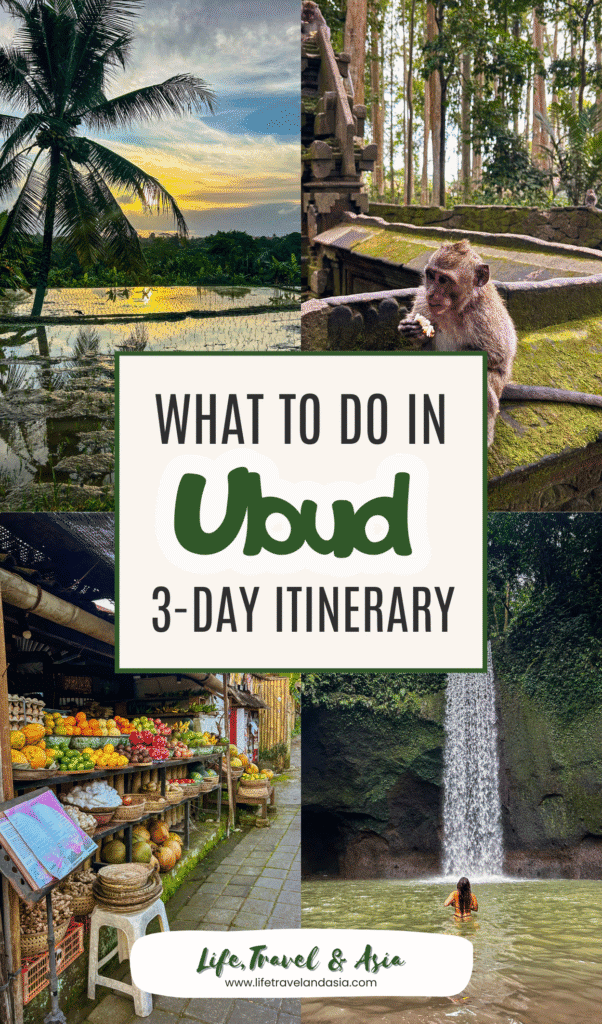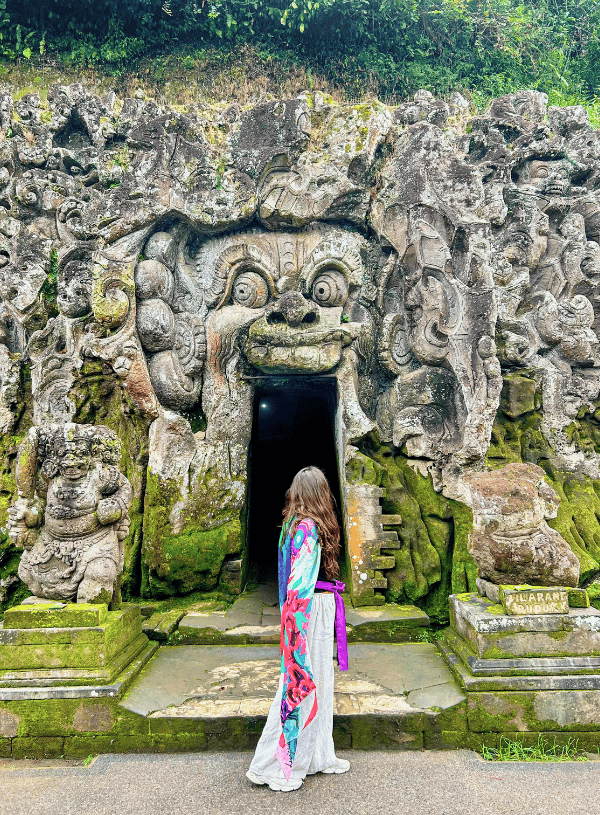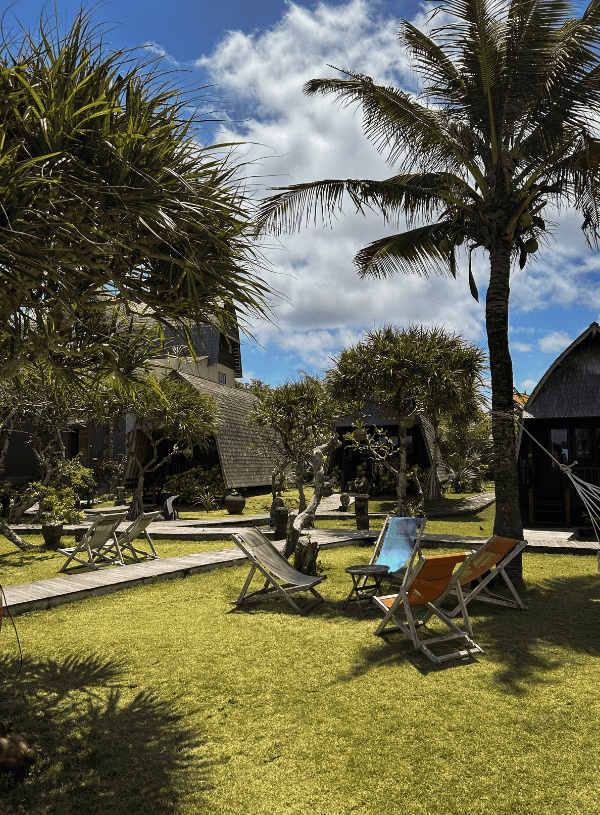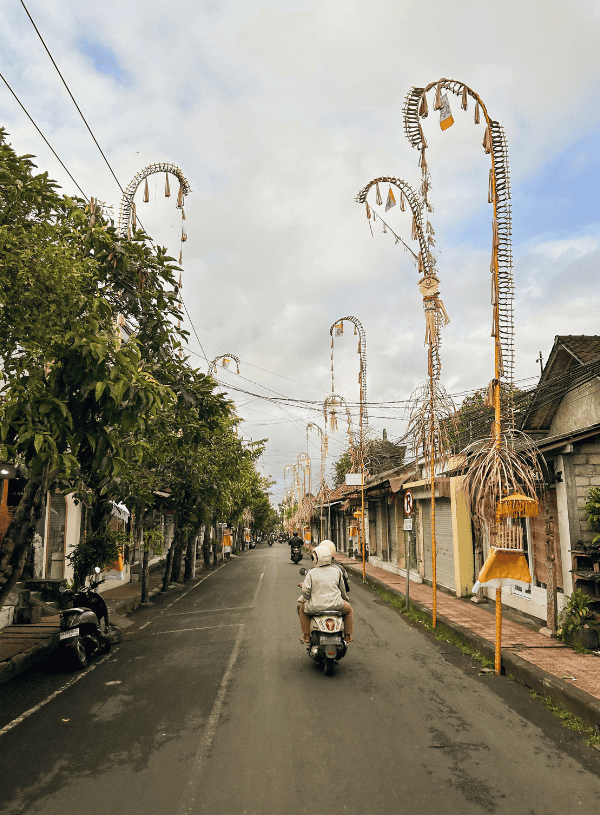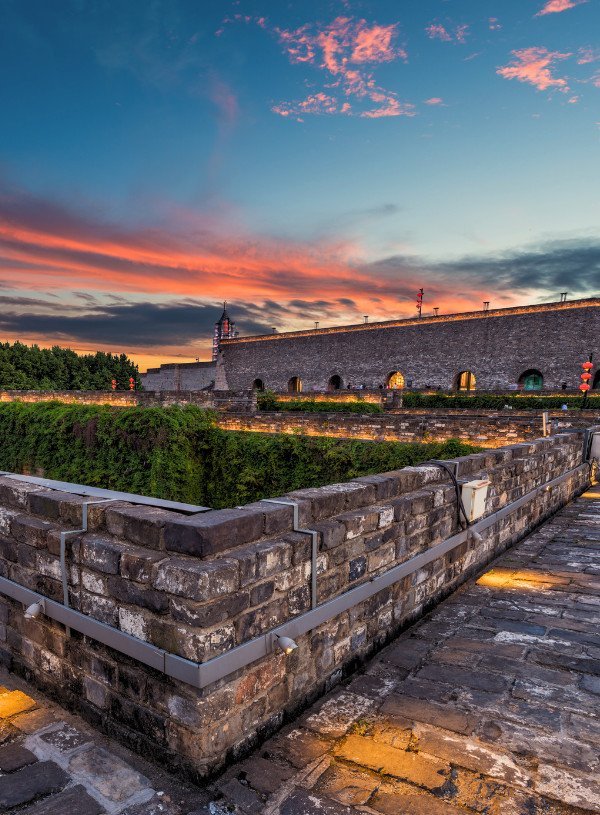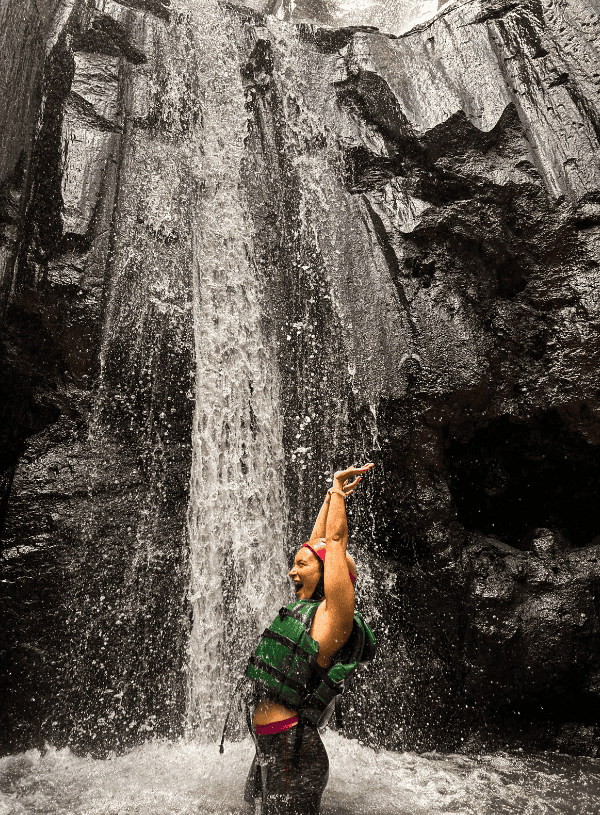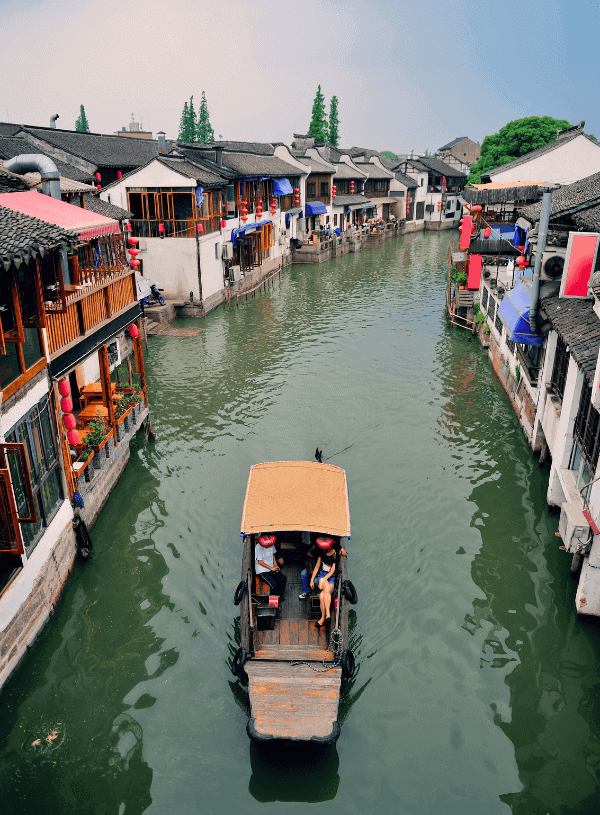3 Days in Ubud: The Perfect Itinerary for First-Time Visitors
Last Updated on October 12, 2025
Are you planning to spend 3 days in Ubud and hoping to experience the best in town, along with the most interesting (and less crowded) sights nearby? You’re in for a treat.
I’ve been living in Ubud for a while now and, between random waterfall-hopping days, Sunday morning temple visits, and endless walks through rice fields, I’ve seen it all: the traffic, the crowds, but most importantly, the beauty, the nature, and all the magic Ubud has to offer.
In this guide, you’ll find the exact 3-day Ubud itinerary I’d take my best friends on: my favorite waterfalls, hidden temples, and all the tips to enjoy Bali’s spiritual soul while trying to escape the crowds.
This article may contain affiliate links. This means that if you purchase through one of the links, I may be paid a small commission at no extra cost to you. Thank you for supporting the blog and allowing me to keep sharing meaningful travel experiences with you.
Don’t have time now?📌 Save it for later!
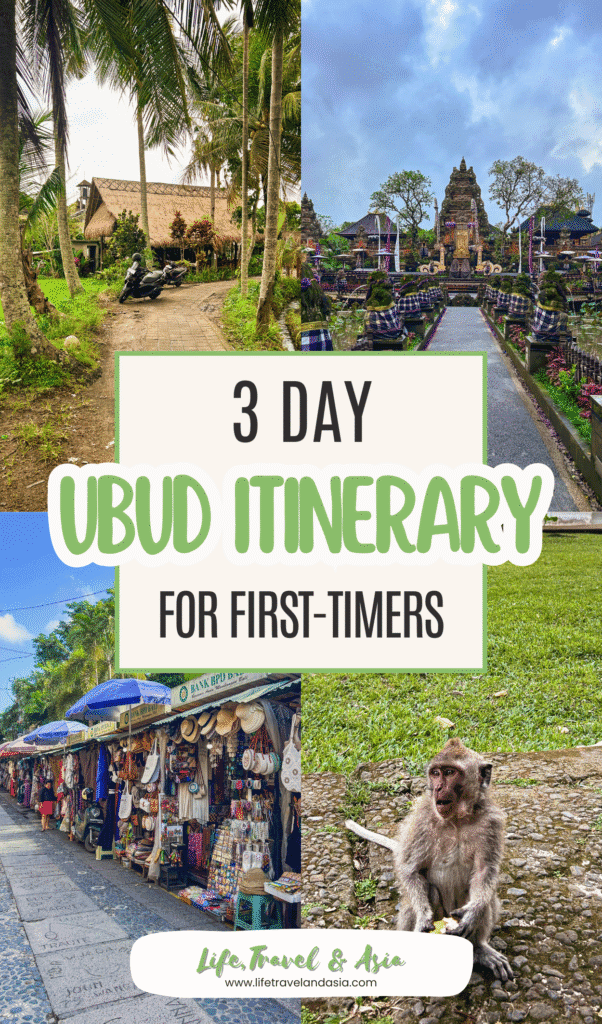
Best Experiences in Ubud
Why Is Ubud Worth Visiting?
A couple of weeks ago, I watched a video where a girl suggested skipping Ubud on a Bali itinerary because it’s getting too busy. And while that’s not entirely false, hear me out.
Yes, Ubud can feel crowded—sometimes as much as Canggu or Seminyak—but its real beauty lies in how easily you can escape.
Just a short walk away from the main roads, you’ll find yourself in almost empty rice fields, surrounded by towering trees and silence so pure you remember you’re on a tropical island where nature is everywhere.
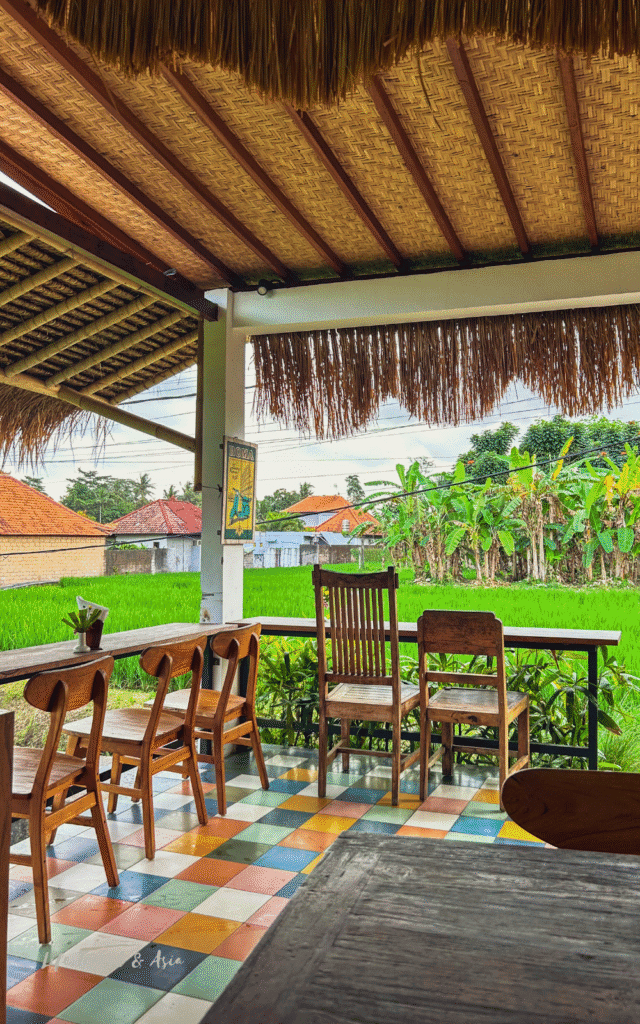
To me, Ubud feels like an open-air temple. If you type “temples” on Google Maps, you’ll see just how many are scattered around town.
Most are active worship sites and not open to visitors, but even just walking past them, you can sense why Ubud is known as the spiritual heart of Bali. Step away from Jalan Raya, stroll around, and you’ll feel it too.
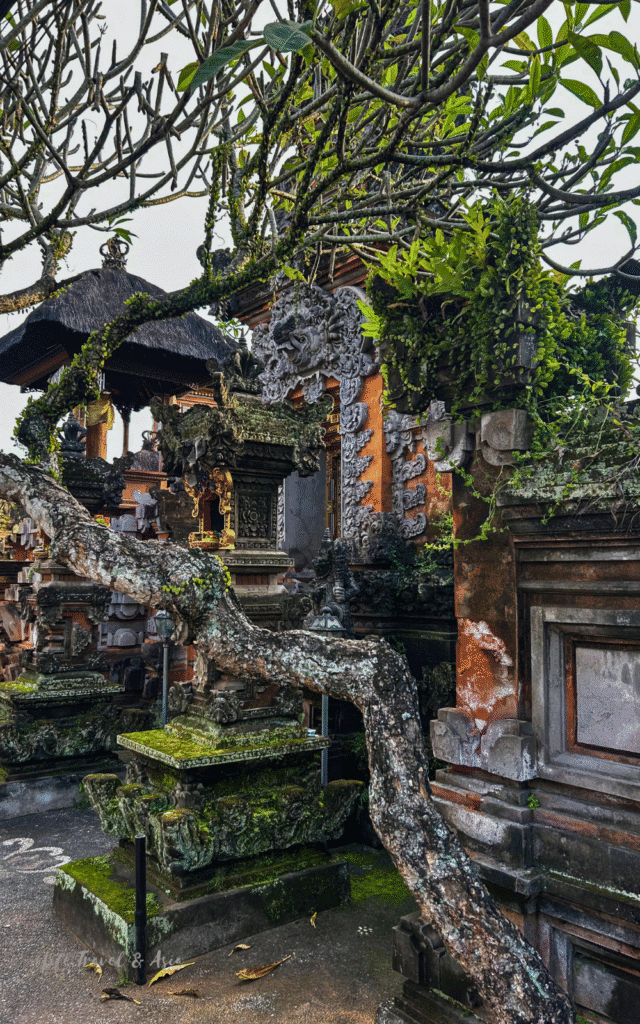
And beyond the town itself, Ubud is perfectly located in the heart of Bali, making it the ideal base for day trips to central, northern, and eastern Bali. In fact, if you’re planning 3 days in Ubud, you might just want to extend to 5. I’ll share some fun day trips at the end of this post in case you do.
How To Get to Ubud
Ubud is located in Gianyar Regency, about 40 kilometers from Ngurah Rai International Airport (DPS). Depending on your arrival time, the journey can take up to two hours, especially during the afternoon rush hour.
From the airport, you have several options to get to Ubud.
Pre-Booked Car
The easiest way to get from the airport to anywhere in Bali. After a long flight, there’s nothing better than landing and knowing your driver is waiting—no stress and no risk of being overcharged.
I’ve used Klook to book my driver on both of my trips to Bali and had a great experience, so that’s what I recommend if you’d like to arrange your ride in advance.
Taxi From The Airport
I’ve never personally taken a cab at the airport, but once you land, it’s impossible to miss them — drivers will approach you as soon as you step into the arrivals area. To give you an idea of prices, with a pre-booked service, I’ve paid around $18 to Ubud and about $9 to Seminyak.
Grab or Gojek
You might be able to book a Grab or Gojek car (or even a bike if you’re traveling light) directly from the airport. However, ride-hailing services aren’t always allowed inside the arrivals area, so you may need to walk outside the airport gates to meet your driver.
Where To Stay in Ubud
You definitely won’t be short on options when it comes to deciding where to stay in Ubud—there’s something for everyone. From budget guesthouses to boutique hotels, private villas, and jungle bungalows, it just depends on your vibe.
To make things easier, I’ve put together a quick guide to the best areas to stay in Ubud based on your travel style and interests. I’ve also added my favorite restaurants and things to do in each area, so you can be sure your stay not only meets but exceeds your expectations.
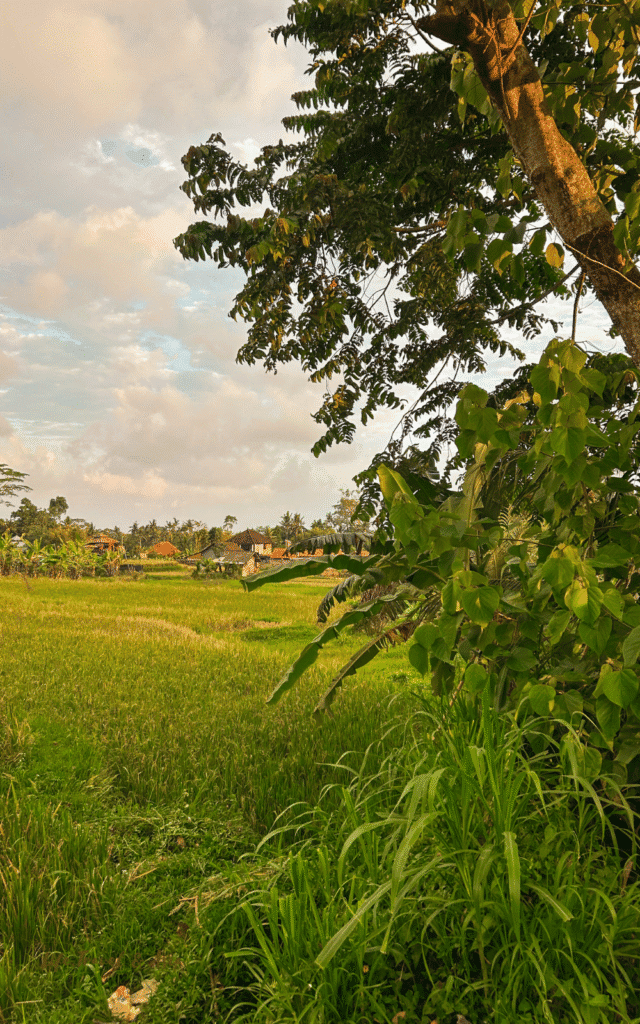
Low-Budget Options
Utu Homestay: This homestay is right at the start of Jl. Sukma, within walking distance of the main road and has an authentic Balinese atmosphere. The rooms are part of a traditional Balinese home compound, so you’ll see the family around and experience local life. Rooms are clean, spacious, and comfortable, especially considering the price.
Bisma Jaya Bungalow: I lived for a couple of months, and it was the perfect stay for me. The rooms are simple, but the atmosphere is incredibly peaceful. The staff is so friendly and the garden is beautifully maintained. There’s a lovely swimming pool overlooking the surrounding nature. Each bed comes with a mosquito net, which is a plus in Bali — trust me, you’ll be grateful for it.
Mid-Budget Option
Sens Hotel & Spa: Its location is right at the entrance of Jl. Sukma, a great option if you want to stay close to the main road. The building itself is hard to miss, with its clean, modern look — and the rooms feel both cozy and stylish. The outdoor pool is a real highlight, and despite its central location, the hotel remains quiet and peaceful.
Nur Guest House: The relaxing vibe in this little corner of the Sari Organik Walk is unbeatable. The pool area is beautiful, and the surrounding rice fields make it the perfect spot for a morning view. Every bed has mosquito net and the property is just steps away from Monkey Bar — one of my favorite cafés in Ubud.
High-Budget Option
Bisma Eight: One of the most iconic boutique hotels in Ubud — you really can’t go wrong here. The hotel is stunning, with infinity pools offering 360° views of the jungle. It feels like a peaceful oasis, yet remains close to the city center. Service is top-notch, and if you’re looking for an upscale and luxurious experience in Ubud, this is the place.
Prana Eco Wooden Villa: This is what you’re looking for if you’re dreaming of a private, intimate, and magical stay in the Ubud rice fields. This newly built wooden villa offers total privacy, and the real highlight is the staff—super supportive and always ready to help when needed.
How To Get Around Ubud
The center area of Ubud is very much walkable; however, to explore some of the sights nearby, you should consider one of these options below to get around.
Scooter Rental
Renting a scooter is by far the most flexible and budget-friendly way to get around Ubud. If you’re confident driving in busy traffic and on hilly roads, you’ll be fine.
Most roads are well paved, but be mindful of the steep ups and downs and the occasional dogs that like to “own” the streets in smaller villages. For a reliable option, I recommend Ubud Scooter Rental.
Private Driver
If you don’t feel comfortable driving, you can consider hiring a driver to plan your day trips around Ubud. You can book a driver for up to 10-12 hours, agree on an itinerary, and he will be able to drive you around. If you’re looking to hire drivers, this is one of my favorite services.
And if you’re looking for a hilarious, English-speaking, and trustworthy driver, Darmesta is happy to drive you around. You can contact him at this number (+62 822 6476 5198) any time!
Day Tours
If you don’t want to stress about transportation or planning, booking a day tour is the easiest option—you just need to show up on time for pickup.
The only problem I have with most day tours is that they all leave at the same time, go to the same places, and you end up seeing everything with a huge crowd.
3-Day Ubud Itinerary Overview
The best way to plan your 3-day Ubud itinerary is to visit the classics first thing in the morning—this way you’ll enjoy them with fewer crowds. With three full days, it’s totally doable.
| Day 1 | Day 2 | Day 3 |
| Morning Market | Tegallalang Rice Terraces | Waterfall-Hopping Morning |
| Rice Field Breakfast | Purification Ceremony | Goa Gajah |
| Ubud’s Palace | Pura Tirta Empul | Sacred Monkey Forest or Trip to Sangeh Sanctuary |
| Saraswati Temple | Lunch | Shopping at Ubud Market |
| Lunch | Cooking Class | Massage or Spa Treatments |
| White-water Rafting | ||
| Traditional Dance Performance |
Day 1: Ubud Classics, Rice Fields & Fun in Nature
1. Plan a Visit to The Morning Market
From 9 am onwards, Ubud Market transforms into a souvenir haven (and chaos central). It’s the spot to pick up gifts and practice your bargaining skills—fun, but not the most peaceful experience.
If you head there earlier, around 7 am, you’ll see a completely different side of the market. This is when locals come to buy and sell fresh fruits and vegetables, as well as the flowers they use for their Canang Sari offerings.
It’s a much calmer and more authentic experience—and honestly, one of the nicest ways to start your morning in Ubud.
2. Breakfast in The Rice Fields
From Ubud Market, you can easily walk to Jl. Kajeng rice fields and the Sweet Orange Trail. It’s kind of crazy to think that just five minutes from the busy main road, you’re suddenly surrounded by this scenery.
This is one of the nicest rice field walks in Ubud, followed by breakfast—there’s just something grounding about stepping onto the trail, and there are a few cafés along the way with stunning rice field views.
My two favorites here are Sweet Orange Warung and Aldi’s Coffee and Eatery.
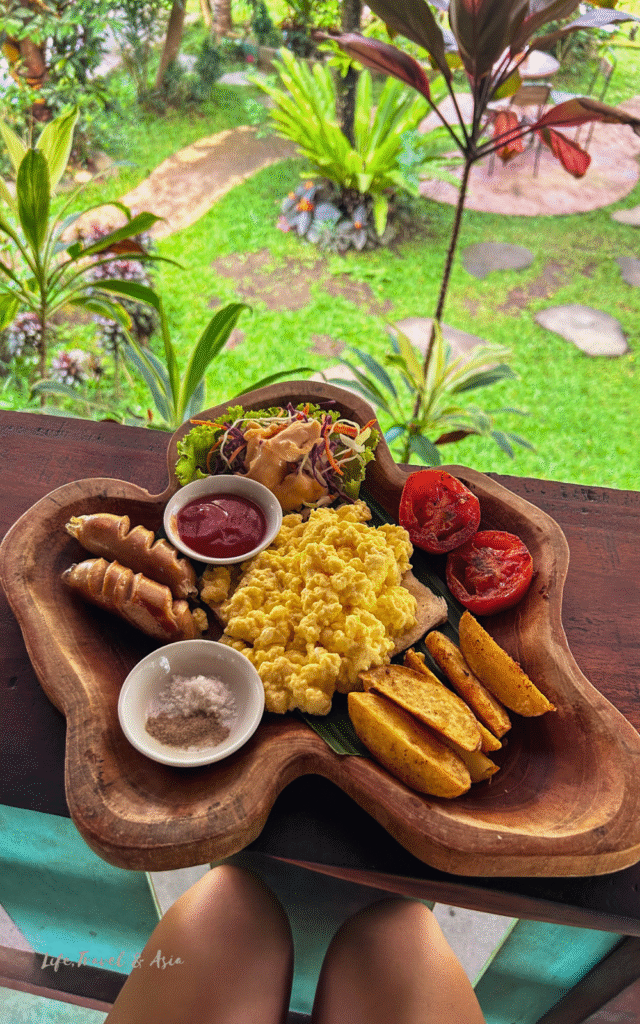
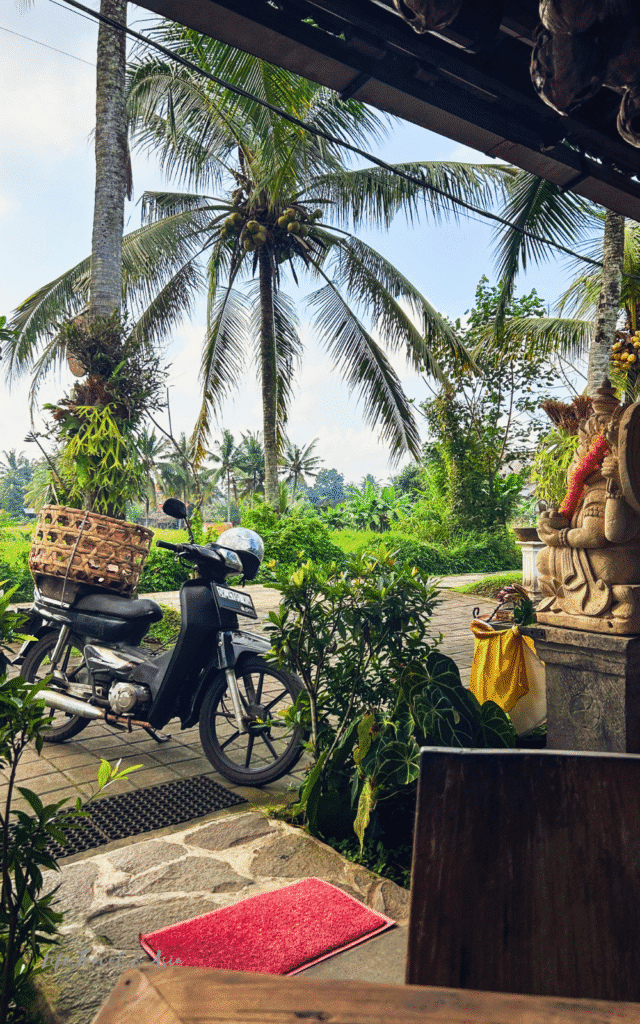
Sweet Orange Warung is at the start of the Sweet Orange Trail (if you enter from the Suwak Juwuk Manis Walk sign on Jl. Raya). I keep coming back for the atmosphere: peaceful, calm, almost spiritual—especially in the morning when soft instrumental music is playing.
The food doesn’t disappoint either: you’ll find all the usual egg variations, sourdough toasts, smoothie bowls, and even Indonesian specialties in breakfast form (yes, Gado Gado for breakfast is pretty good).
Aldi’s, on the other hand, is right at the beginning of the trail if you come from Jl. Kajeng. It’s easy to miss, but it’s worth stopping by. The menu is smaller, but their savory breakfasts are so good and affordable, as well as their smoothie bowls.
3. Ubud’s Royal Palace: Puri Saren Agung
💵 Ticket Price: Free entrance
Ubud Royal Palace is right in the Center of Ubud, right in front of the Ubud market, surrounded by the constant hum of traffic and the voices of tourists passing by. Yet, the moment you step inside, it’s surprisingly quiet — you can barely hear a thing from the outside.
The palace opens around 7:45 to 8 AM (not at 7), and that’s honestly the best time to visit if you want to enjoy it without the crowds or tour groups.

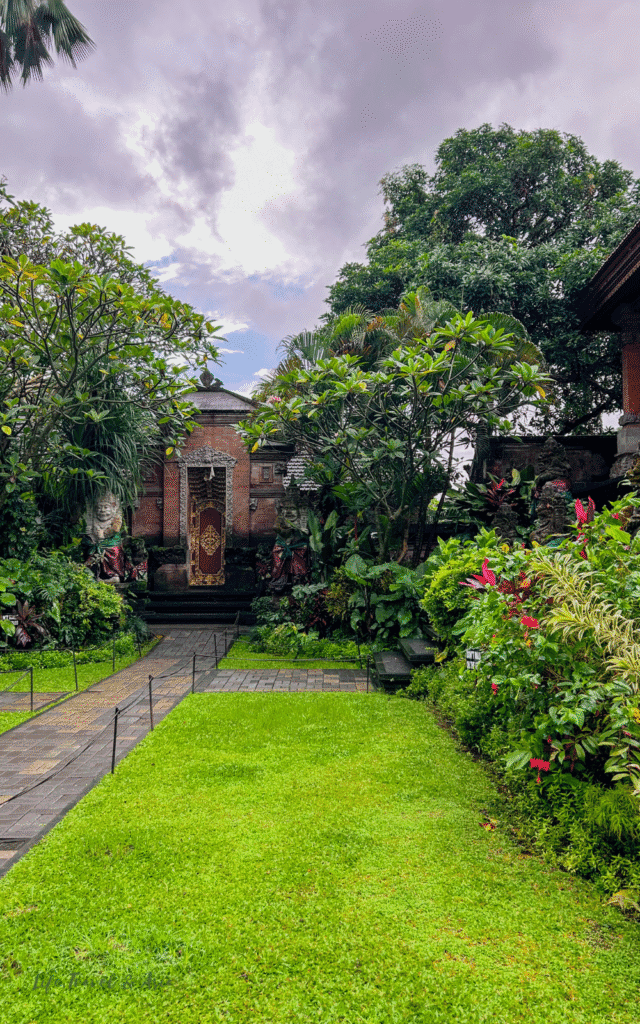
The site itself isn’t huge, and you’ll not need to pay an entrance ticket. There are two separate areas you can explore, and you won’t need more than 15 to 20 minutes to walk around.
You’ll have the chance to admire the beautiful Balinese architecture, golden shrines, towering red-sandstone gates, and the lush green garden in peace. Everything is so well-maintained and curated, it’s honestly very beautiful.
4. Saraswati Temple
💵 Ticket Price: IDR 60K ($4)
The Saraswati Temple is dedicated to the Goddess Saraswati, just a short walk from the Ubud Palace. As a visitor, you can only explore the garden — the temple itself is closed to the public.
That being said, the garden is honestly one of the prettiest you’ll find in Ubud, and it feels so different from the typical traditional Hindu sites.
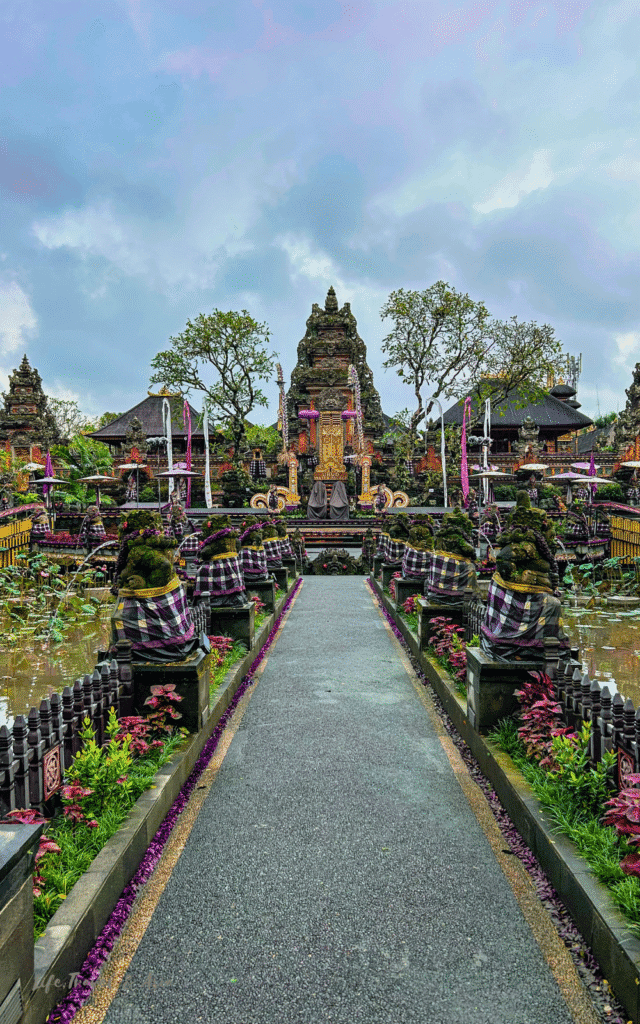
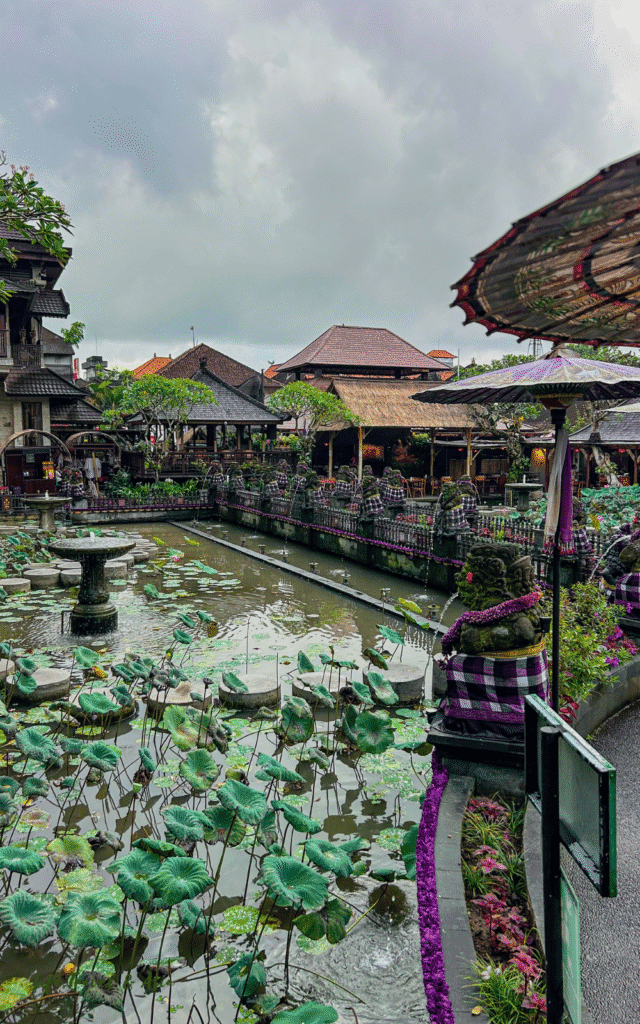
The garden is small, and it takes around 30 minutes to explore. Still, every little corner is full of unique architectural details — from the bridge crossing the pond, to the detailed statues decorating it, to the red sandstone gates standing at the corners of the garden.
I highly recommend arriving right after opening time, around 8:00 AM. When I visited at that time, there was no one else around. I passed by on the same day at 12, and there was a very long queue of people waiting to get in, and the site was packed (which is not ideal as it’s tiny).
5. White-Water Rafting
From 9–10 am onwards, Ubud center gets packed, which is why I highly suggest escaping the crowds around lunchtime and planning a fun activity just outside town.
White-water rafting is one of the most fun experiences you can have in Ubud. I’ve done it twice at this point, and honestly, it’s always a highlight. If you’re unsure whether rafting is right for you, you can discover my rafting experience in Ubud in this blog post.
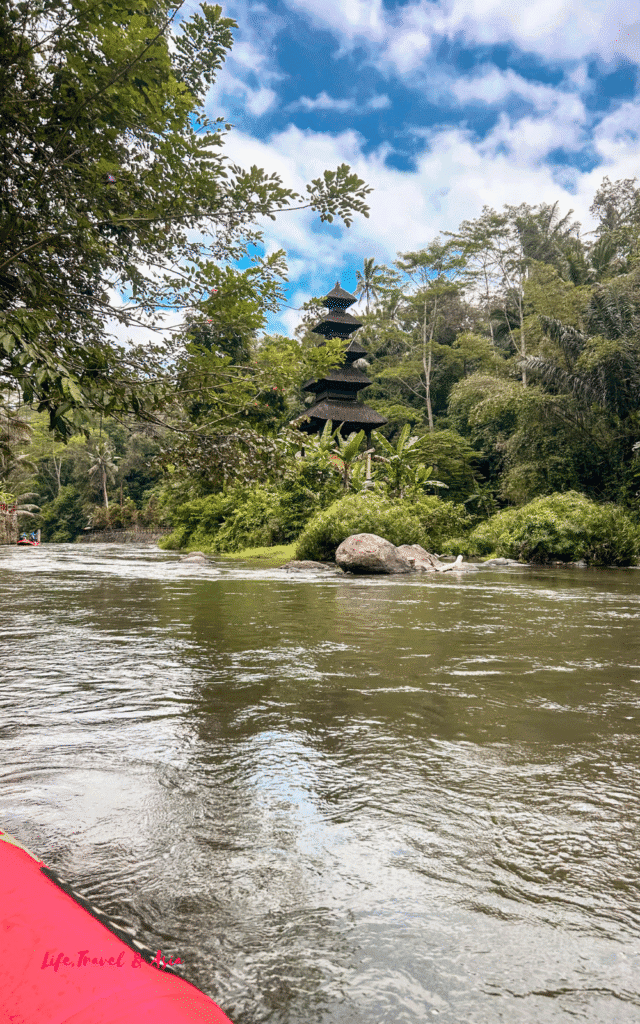

The rafting lasts around 2 hours and is relatively easy, but still offers enough challenges for both beginners and rafting experts.
I booked my trip with the Balinese company Graha Adventure. They handled everything—providing all the equipment, arranging transportation to and from the river, and having their staff guide us along the way. Depending on your booking time, lunch might even be included back at their base.
6. Attend a Balinese Dance Performance
After your rafting experience, you can head back to your accommodation, take a rest after the physical effort, and maybe plan something a bit more cultural for the evening.
Ubud is the place to experience Balinese dance performances. They usually start around 7 pm and are held in temples almost every night — like Saraswati Temple, Pura Dalem Ubud, Pura Puseh on Jl. Suweta, and even the Ubud Palace.

Every evening you’ll find different shows: the Kecak Fire Dance (which is the one I went to), a hypnotic performance with male chanting; the Barong Dance, telling the story of good vs. evil; and the Legong Dance, performed by young women with so much grace and elegance.
To get tickets, you can simply walk around Ubud Palace in the afternoon where plenty of vendors are selling them. I definitely suggest arriving early to grab a good seat because the shows get really packed (to my surprise!).
Performances usually last one hour, and you can plan to have dinner later.
7. Dinner at a Local Warung
Depending on where you’re attending your Balinese dance performance, you can head to one of my favorite warungs near Ubud Center.
Warungs are affordable local eateries where you’ll mostly find Indonesian specialties, but many also offer a few international options to please everyone.
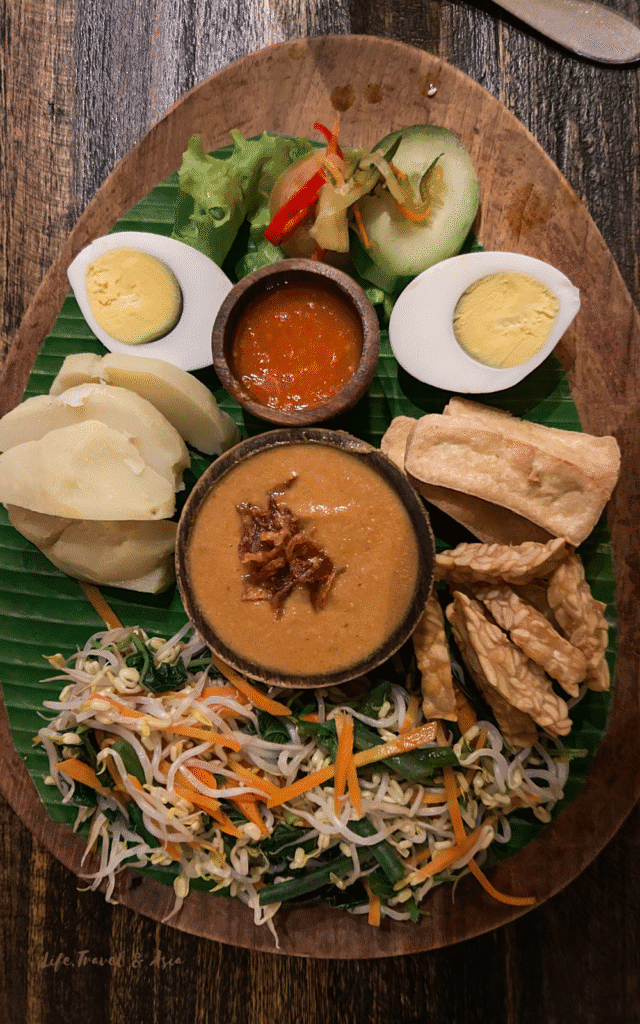
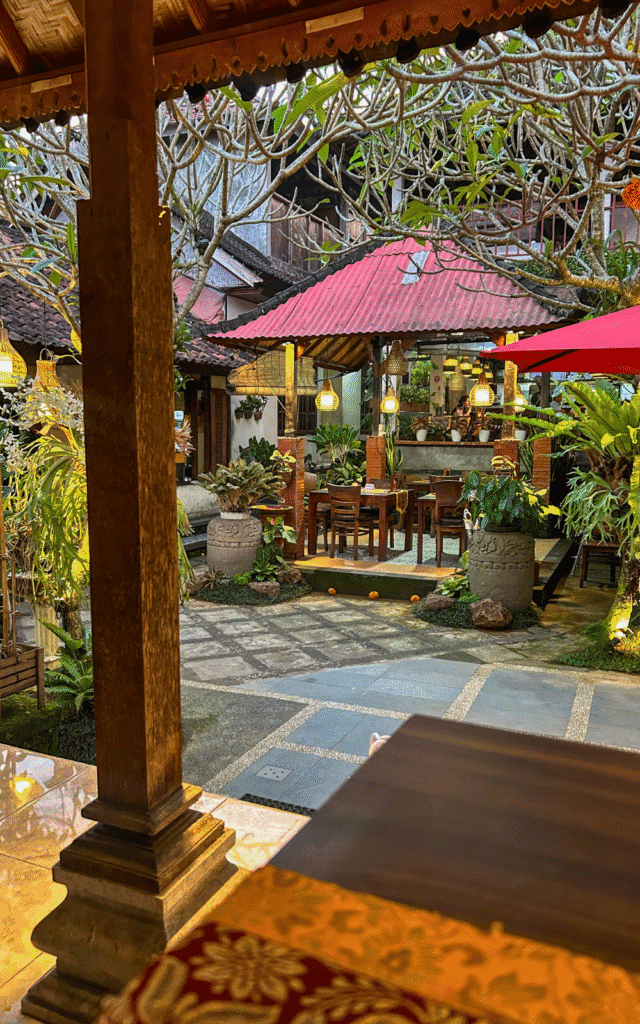
Close to the city center, my top picks are: Compound Warung on Jl. Goutama (though you might have to wait a little to get a seat), Warung Makan Bu Rus on Jl. Suweta — close to the Ubud Palace or Pura Puseh — and Warung Biah Biah, also on Jl. Goutama, with its friendly atmosphere and shared tables.
Looking for more warungs, international restaurants, and cafés to try in Ubud? Here are 15+ favorite places to eat in Ubud you should definitely check out (or at least a few of them!).
Day 2: Exploring Rice Fields, Temples, and Rituals North of Ubud
The northern area of Ubud is a tourist favorite, mostly thanks to the famous Tegallalang Rice Terraces and Pura Tirta Empul, the water temple where visitors take part in the Balinese purification ceremony.
However, beyond these two highlights, there are many other temples worth exploring. I’ll suggest a few below (I know a full temple-hopping day isn’t exactly everyone’s idea of fun!).
1. Tegallalang Rice Terraces
💵 Ticket Price: IDR 75K ($4.5)
While I think there are more beautiful rice fields around Ubud, the Tegallalang Rice Terraces are still a must-see for first-time visitors — and I completely understand why most people want to see them.
(If you’re staying in Ubud for more than 3 days, make sure to check out the day trips I suggest below — there are some stunning alternatives in Central Bali).


The terraces open at 7 am, and that’s when I recommend going. I know it’s an early call, but you’ll get to enjoy the place without the crowds who usually stop right at the entrance just for the “ritual” photos.
What really stood out to me here is the terraced layout — it’s so unique and unlike anything I’ve seen elsewhere in Bali.
And if you’re wondering whether they’re worth the visit, I’ve put together a complete Tegallalang guide where I share what I loved (and what I didn’t), plus all the info you need to plan your trip and plenty of photos.
2. Purification Ritual at Pura Mengening or Gunung Kawi Sebatu
The Melukat ritual is a Balinese purification ceremony, meant to cleanse your body, mind, and soul from illness, release negative energy from the past, and allow for a fresh start.
Most people go to Pura Tirta Empul to practice it, but in my opinion, it’s not the best choice.
Unless you book an early morning session, the temple becomes very crowded, and the atmosphere is anything but peaceful (I had imagined something much calmer); my guide even confirmed that locals usually don’t perform their rituals there.
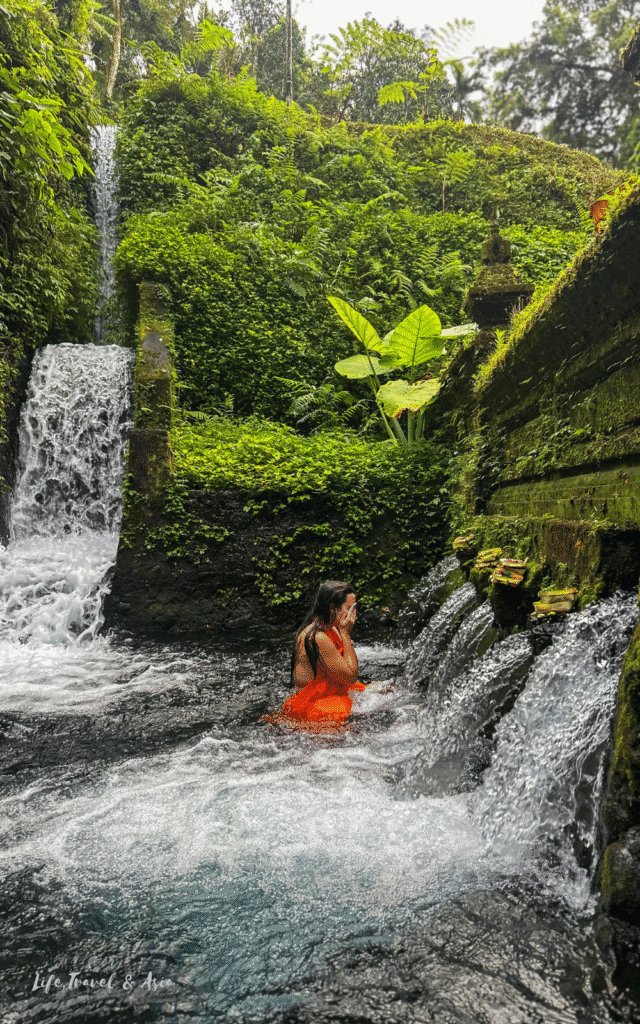

I personally had my Melukat at Pura Mengening, and it was exactly the kind of experience I was hoping for: intimate (it was just me and my guide at the temple), emotional, and deeply meaningful. Honestly, unforgettable.
Another temple I loved is Pura Gunung Kawi Sebatu — one of the most enchanting places I’ve visited around Ubud.
It’s also a great place to experience a truly peaceful Melukat, especially since it’s still off the main tourist path.
Want to book your own Melukat ritual? This is the experience I booked at Pura Mengening. If you feel more drawn to Pura Gunung Kawi Sebatu, you can book this option instead.
3. Pura Tirta Empul
💵 Ticket Price: IDR 75K ($4.5)
While I don’t recommend practicing the Melukat here, Pura Tirta Empul is absolutely worth a visit. After passing through the crowded outer courtyard and the pools where the purification takes place, you’ll reach the most sacred part of the temple.
This is where the holy spring lies, known in Balinese as the jeroan — the inner sacred area where ceremonies are held and locals gather to pray.
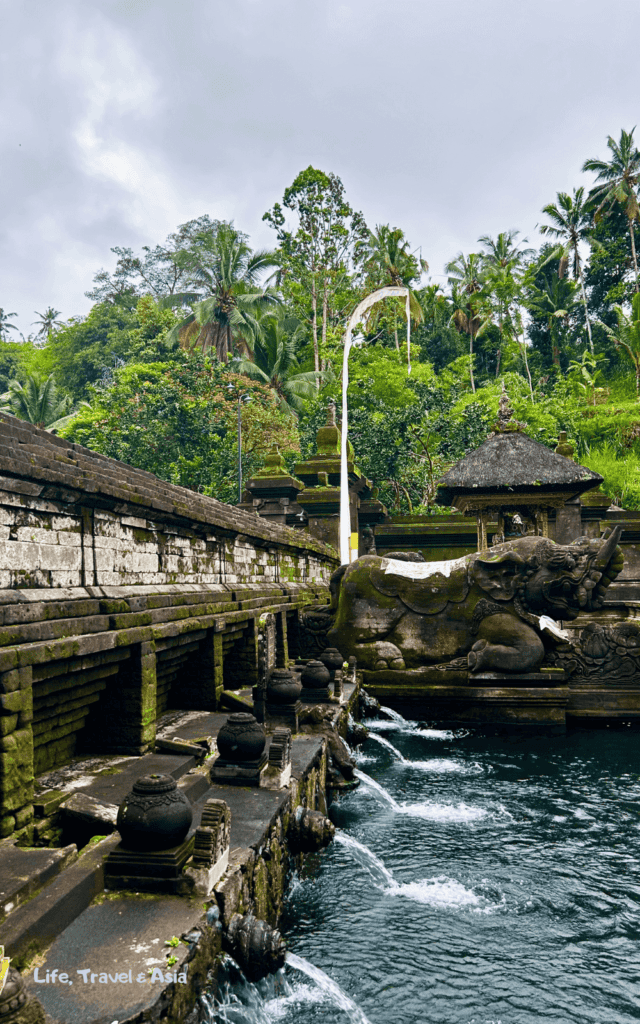

Another highlight is the nature surrounding the temple: thick jungle, towering palm trees, and the most peaceful atmosphere (as long as you step away from the outer courtyards).
The temple is truly beautiful, and it would be a shame to miss it.
Looking for more temples to explore in and around town? Here are my favorite spiritual and religious sites in Ubud.
4. Lunch at Teba Sari
Depending on what time you finish your visit, you can plan to have lunch nearby.
Teba Sari Resto, Bar and Lounge is a great Indonesian and international restaurant to try in the area.
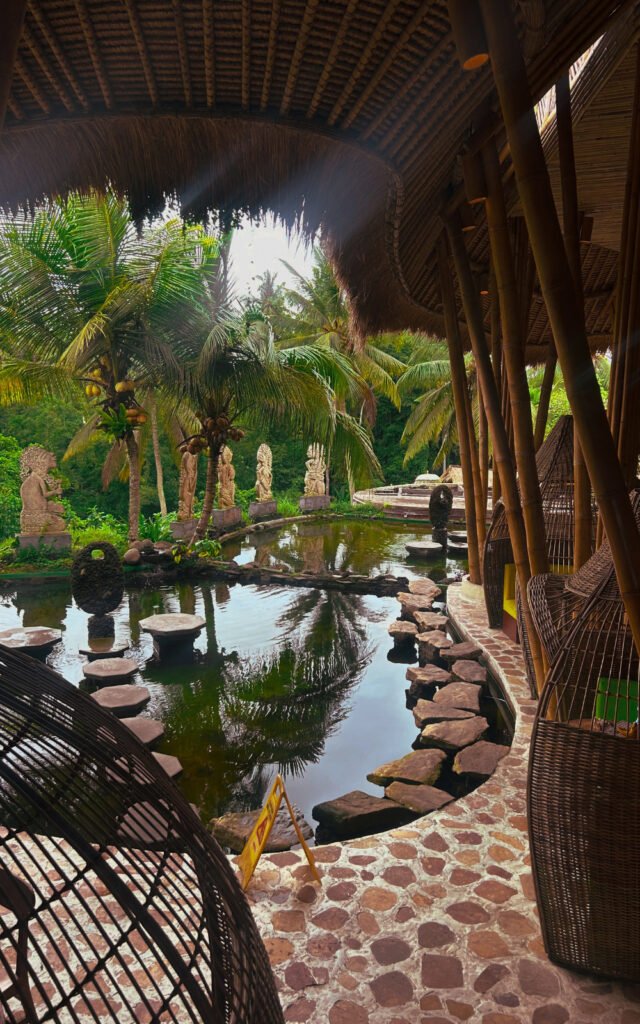
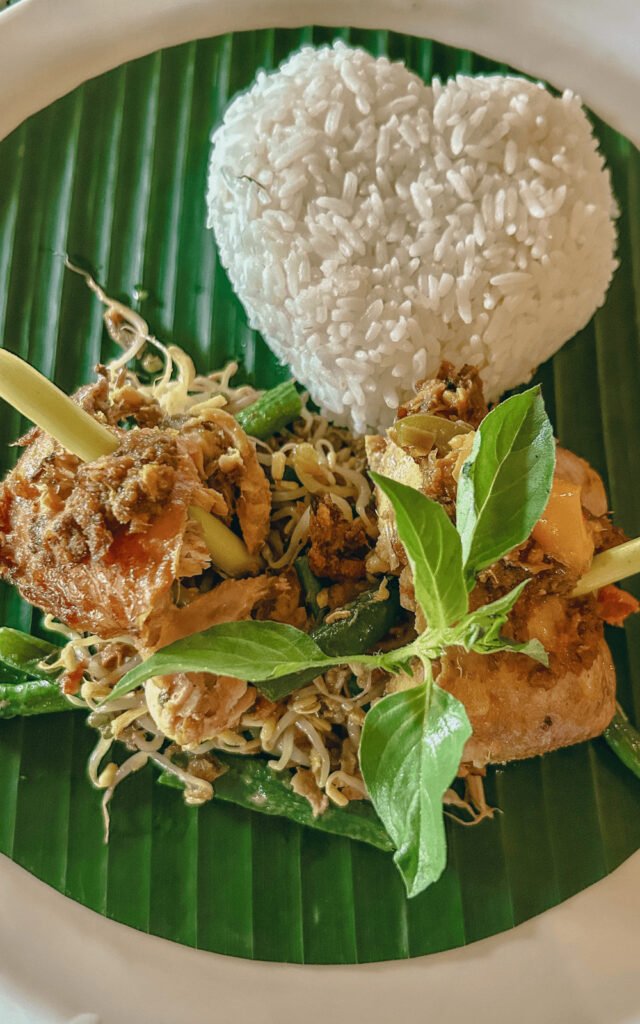
It’s very popular among visitors, not only because it’s close to Tegallalang and Tirta Empul, but also thanks to its stunning jungle views and beautiful bamboo architecture.
If you’re planning to go, I highly recommend booking in advance through their website.
5. Cooking Class Experience
In my opinion, cultural experiences are the best way to connect with the local community and learn more about their traditions, customs, beliefs, and daily lives.
Out of all the options, a cooking class is probably the most fun, engaging, and unforgettable.
In Ubud, you’ll find plenty of cooking classes: some hosted in small traditional villages inside family compounds, some including a Canang Sari offering-making workshop, and others that take you through the traditional morning market.
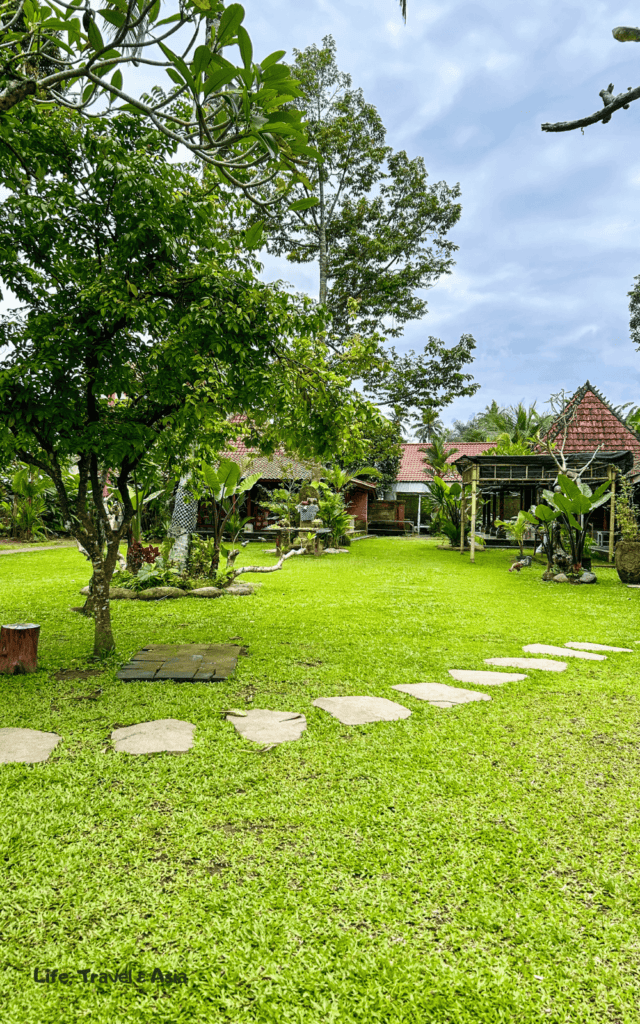

If you’re looking for something authentic and truly immersive, I recommend this experience — it’s the only cooking school in Bali with its own organic farm.
You’ll get to explore the farm, pick your own ingredients, and learn more about the secrets of Balinese cuisine.
It’s the perfect way to spend the afternoon of your second day in Ubud, after all the temple hopping. There is a class starting at 4 pm and ending around 10:30 pm, finishing with a shared dinner of the dishes you prepared yourself.
Curious about what a cooking class in Bali is like? Here’s everything about my amazing cooking class experience in Bongkasa, just outside Ubud.
Day 3: Waterfalls, Elephants & Relax
1. Waterfall-Hopping Morning
💵 Ticket Prices: Every waterfall entrance ranges from 25K to 50K. Bring cash to pay for your entrance.
Around Ubud, there are plenty of waterfalls to explore — from the nearby Tegenungan Waterfall, to the Instagram-famous Kanto Lampo, to lesser-known, tucked away in the north and east.
You really can’t come to Ubud without visiting at least one or two. If you’re set on seeing Kanto Lampo or Tegenungan, I recommend going early, before the tours leave around 9 am. Later in the day, these spots get absolutely packed.
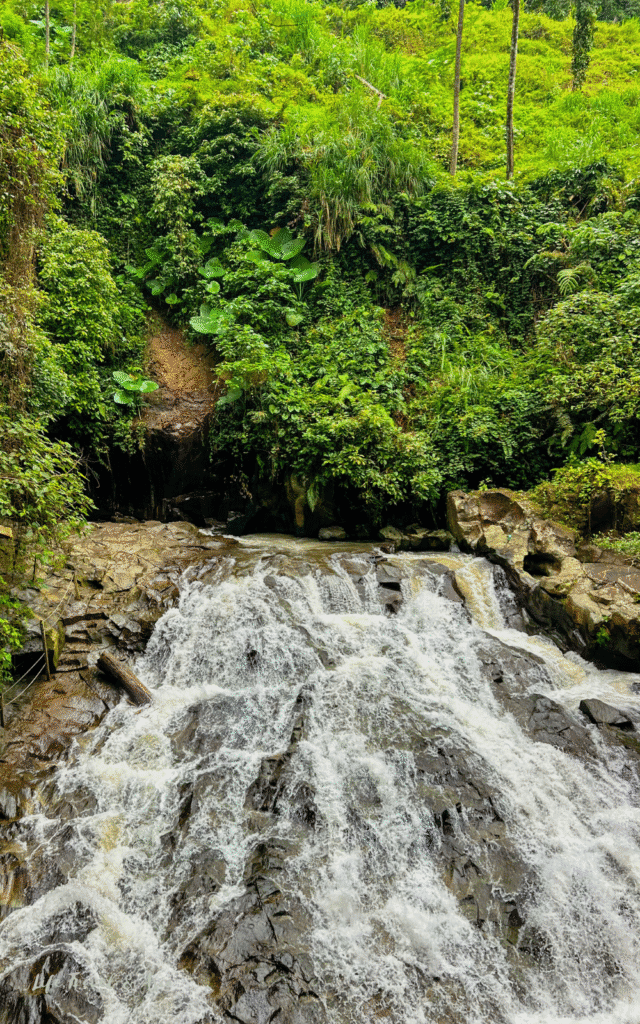
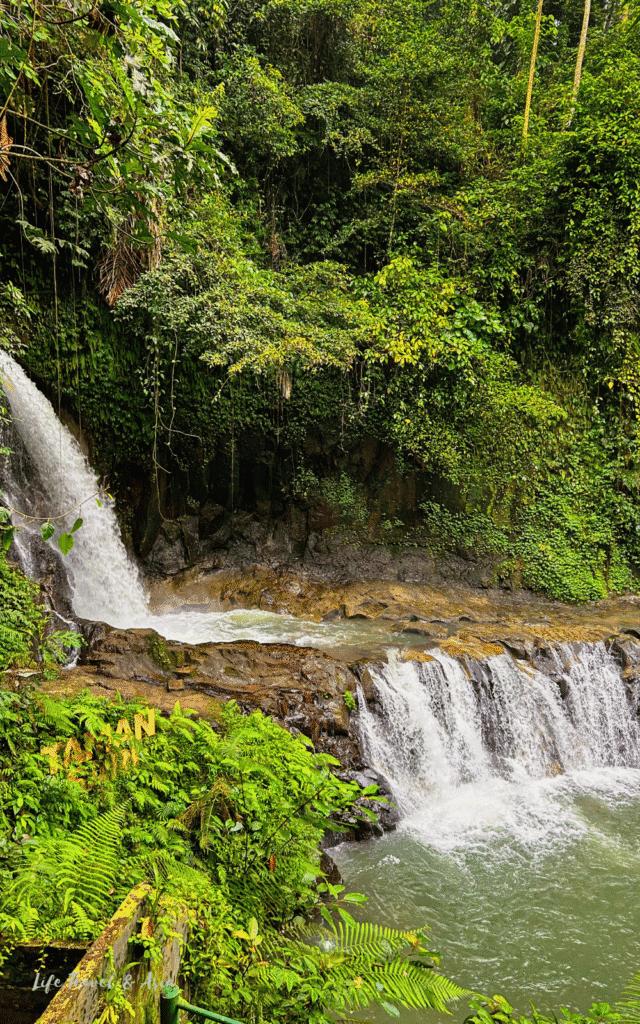
But if, like me, you prefer a more intimate experience — just you and nature (maybe with a couple of other people around) — then head to the waterfalls a bit farther out from town.
Tibumana, Taman Sari, Goa Raja, Tukad Cepung… there are so many to choose from. These are the ones I visited on a morning waterfall-hopping trip, all close to one another — and in total, I only came across about five other people.
2. Goa Gajah (Elephant Cave)
💵 Ticket Prices: IDR 50 K
Nope, there are no native elephants in Bali — and honestly, there isn’t an ethical elephant experience I would recommend here.
What I do suggest instead is visiting Goa Gajah on your way back to Ubud after a morning of waterfall hopping.
Goa Gajah, or the Elephant Cave, is famous for its impressive entrance: you walk into the cave through the mouth of a fierce, intricately carved demon.
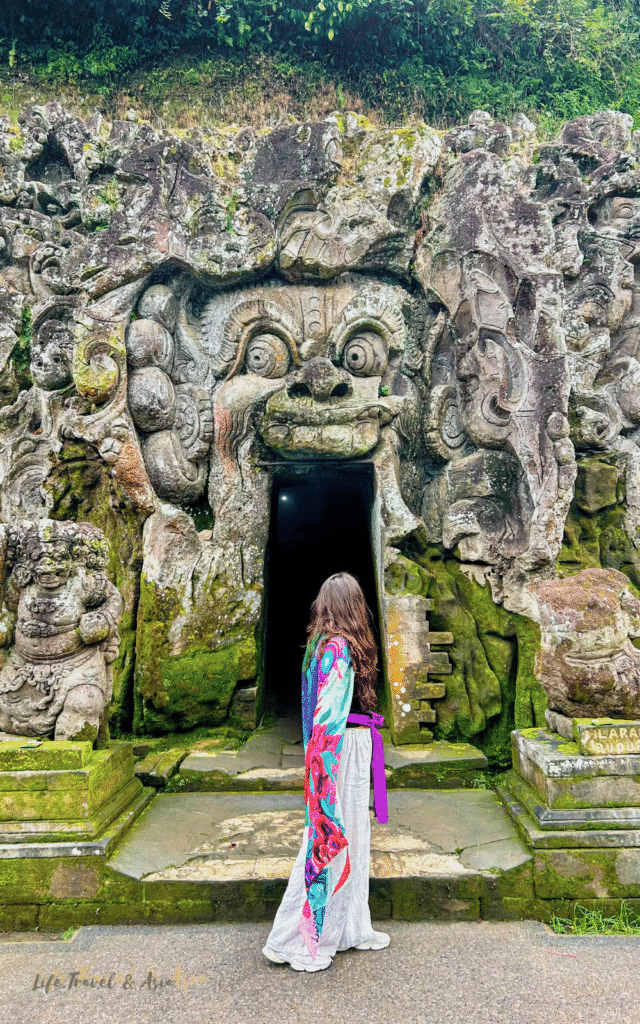
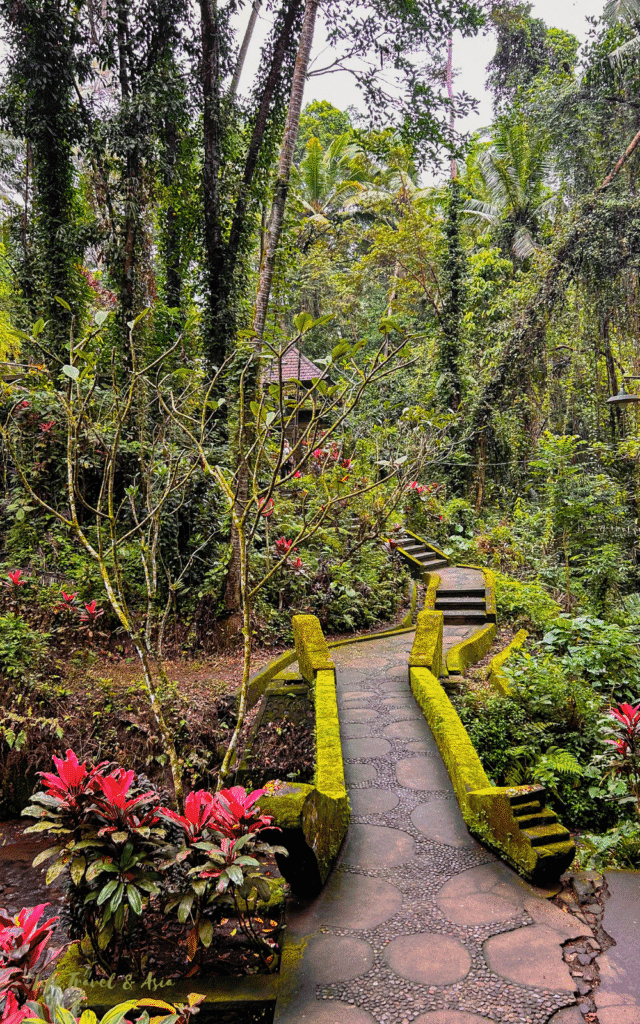
Despite the name, the site has no connection to actual elephants — the name most likely comes from the nearby Petanu River, also known as the Elephant River.
The site is definitely worth a visit. Beyond the cave, you’ll also find two bathing pools decorated with stone statues. If you wander further down toward the Buddhist temple, you’ll discover a lush, colorful, and slightly humid tropical garden.
Need help planning your visit? I’ve put together a detailed blog post with everything you need to know about visiting Goa Gajah.
3. Last Afternoon: Ubud Market, Relax or Funny Monkeys
There are so many things to do in Ubud, and honestly, three days are not nearly enough to experience it all.
That’s why, for your last afternoon, I’ve put together three different options you can squeeze in depending on how much time you have left and when you’re leaving Ubud.
1. Explore The Ubud Market or Jl. Kajeng Market for Last Minute Souvenirs
Everyone comes to Bali planning to take something (or more) back home, and in Ubud, you’ll find two main spots to browse.
The first is the Ubud Art Market, located right in front of the palace and spreading into the labyrinth of little streets behind it.
Here you’ll find all kinds of quirky souvenirs — magnets, t-shirts, bags, wooden crafts, you name it. Just don’t forget to bargain!
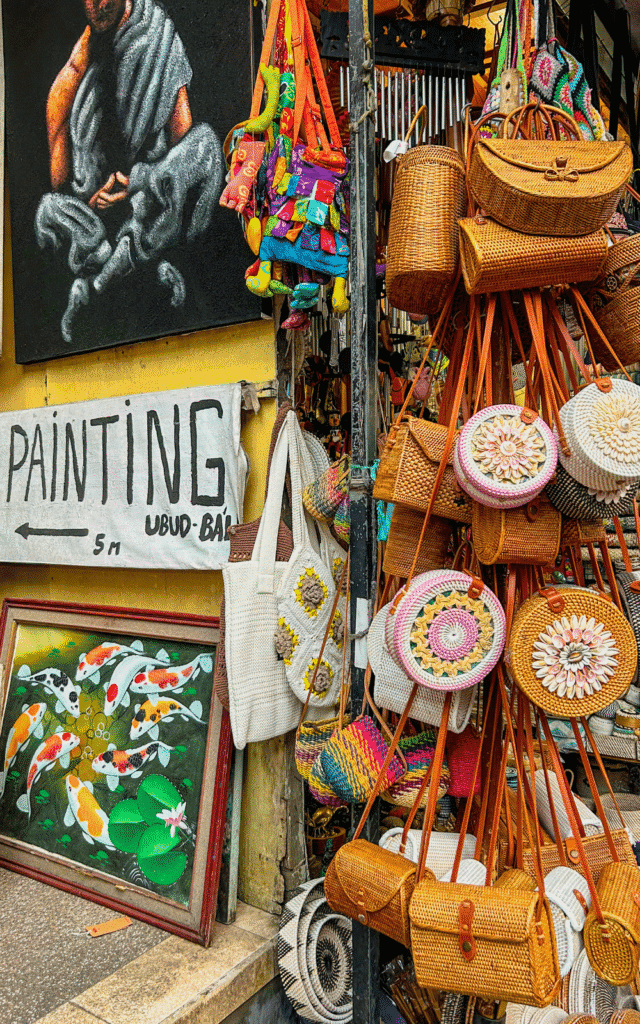

The second, much smaller option, is Jl Kajeng Market — a narrow street lined with little shops on one side and stalls on the other.
In the end, there isn’t a huge difference between the two. Ubud Market has more variety, while Jl. Kajeng Market is usually a bit less crowded.
2. Get Pampered at One of the Many Spas in Ubud
Another way to spend the last couple of hours of your afternoon is to unwind after a packed 3-day itinerary.
In Ubud, you’ll find plenty of spas where you can book anything from a single treatment to a full-on package with multiple therapies.
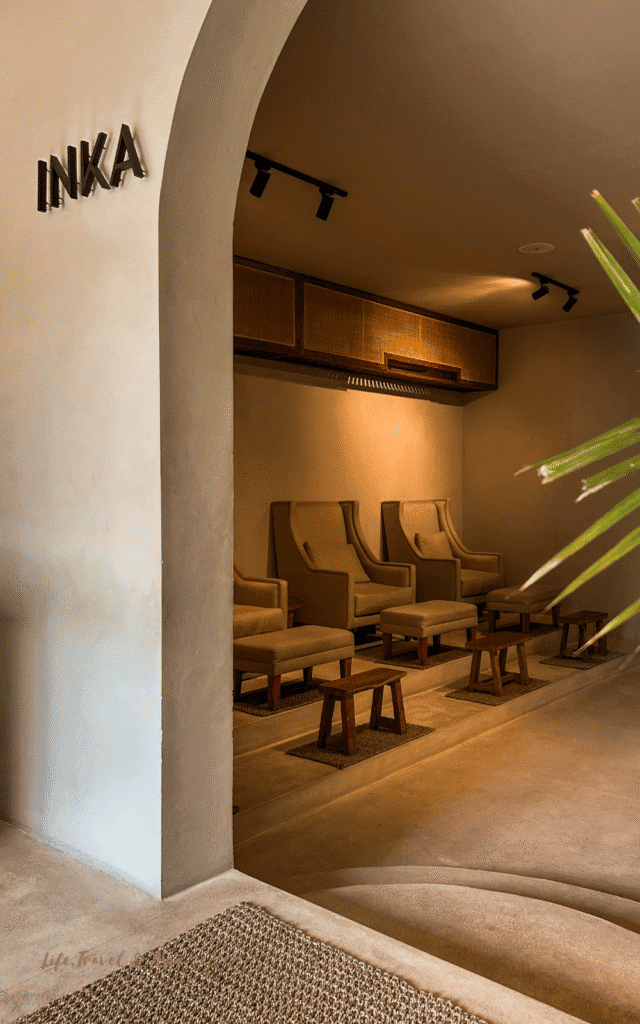
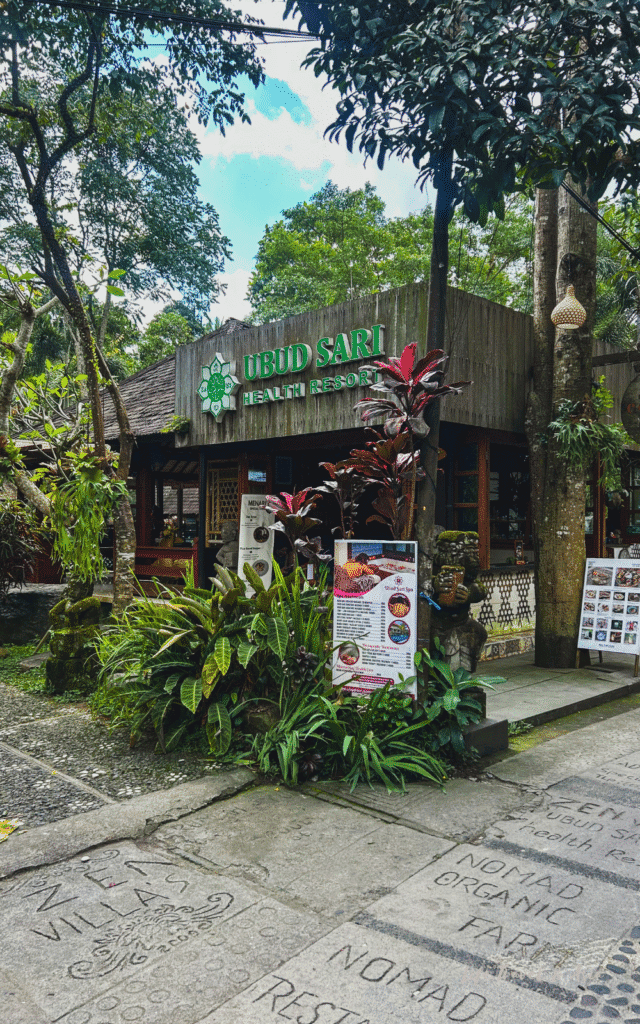
If you’re looking for a balance between quality and affordability, Ubud Sari Health Resort is a good option. A massage here costs around IDR 250K, and it’s a great value for the price.
If you’re in the mood for something more luxurious — and an experience that’s absolutely worth the splurge — check out INKA Spa on Jl. Monkey Forest. I went recently, and honestly, it was the best spa experience I’ve had in Bali so far.
3. Meet The Monkeys
Another Ubud highlight is definitely the monkeys, funny little creatures that can sometimes get way too curious when it comes to small objects.
You can easily spot them in Ubud, especially if you stroll around the Monkey Forest — sometimes without even going inside.
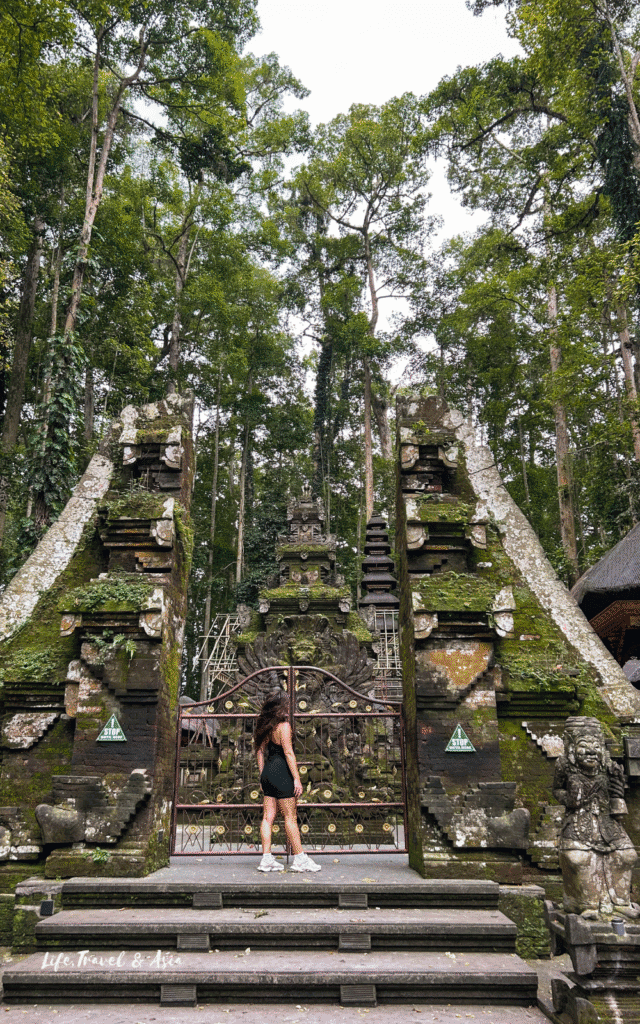
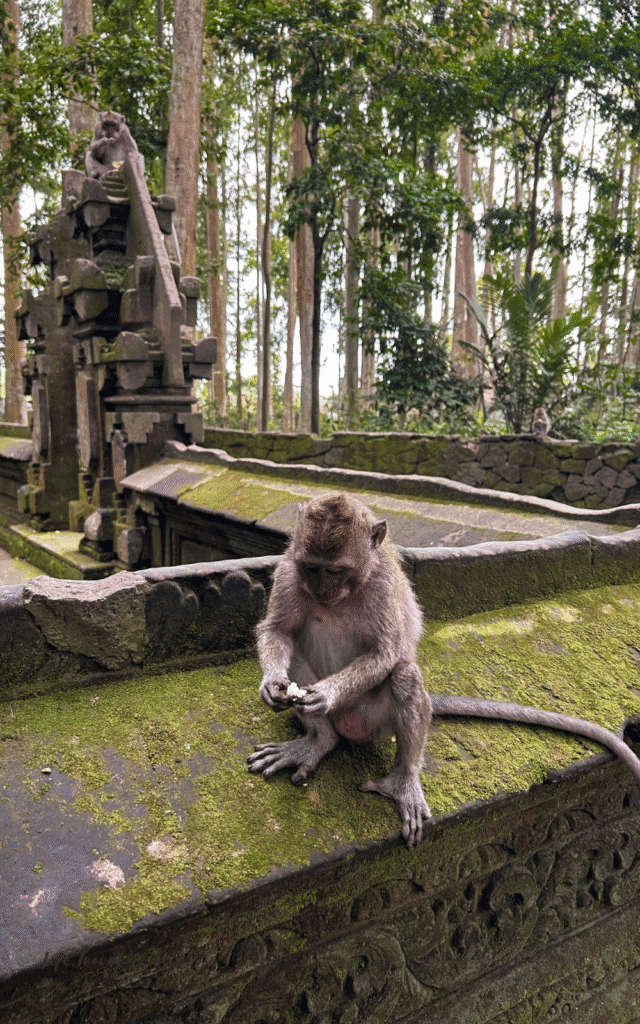
But if you want a closer look, you can plan a visit to the Sacred Monkey Forest in town (save around two hours for it), or ride about 30 minutes by bike to the Sangeh Monkey Forest, in Sangeh village northeast of Ubud.
Sangeh is smaller than the one in Ubud, but here the interaction with the monkeys is actually encouraged, and you’ll even get a basket of food included in the ticket price to feed them.
Are you unsure which monkey sanctuary will provide the best experience? In this post, I break down the differences between the two monkey forests and what you can expect from each visit.
Best Day Trips For a 5-Day Ubud Itinerary
If you’re staying in Ubud for more than three days, here are a couple of day trips that are absolutely worth it and easy to organize.
To plan your day, you can hire a driver and share your itinerary with him. Just make sure to double-check that everything is doable depending on road conditions and traffic (so you won’t end up being disappointed).
If you’d rather skip the logistics, you can also join a tour that covers the exact stops (I’ll suggest some below).
1. Central Bali Day Trip
Bedugul, in Central Bali, is just about 1 hour and 15 minutes from Ubud. This mountain lake area sits at 1,500 m above sea level and feels completely different from the south.
First of all, the climate is much cooler thanks to the altitude. Then there’s the nature: Lake Bratan is the highlight, with its misty mountain atmosphere and a quieter. The vibe is less touristy than “usual Bali” with traditional villages and glimpses of local life.
For a day trip to Central Bali, there are three stops I wouldn’t miss. First, Pura Ulun Danu Beratan, with its enchanting Meru shrines that look like they’re floating on the lake (you can explore the temple or even rent a kayak for a view from the water).
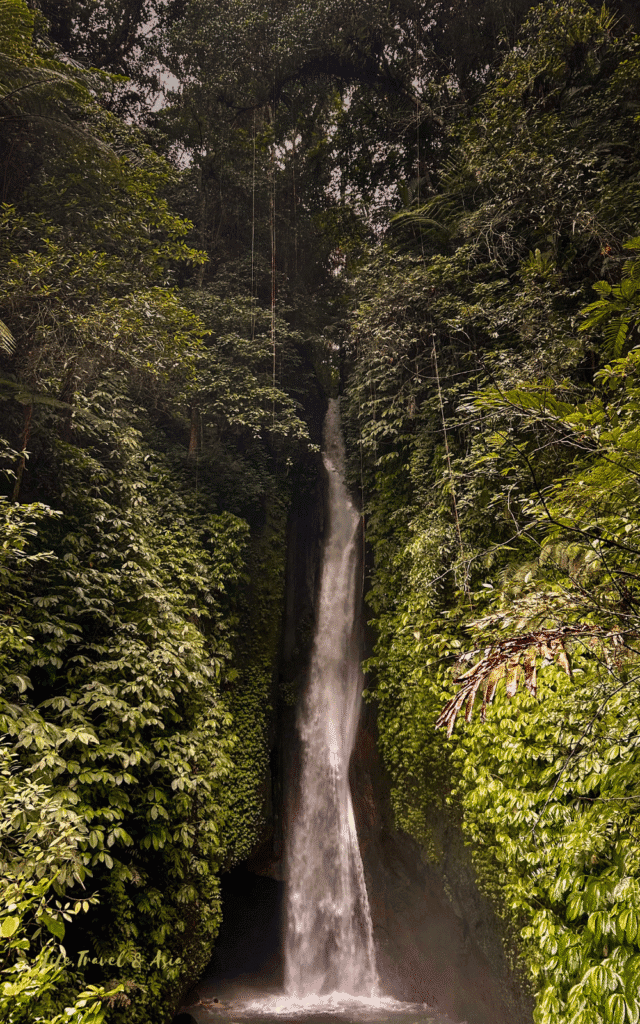
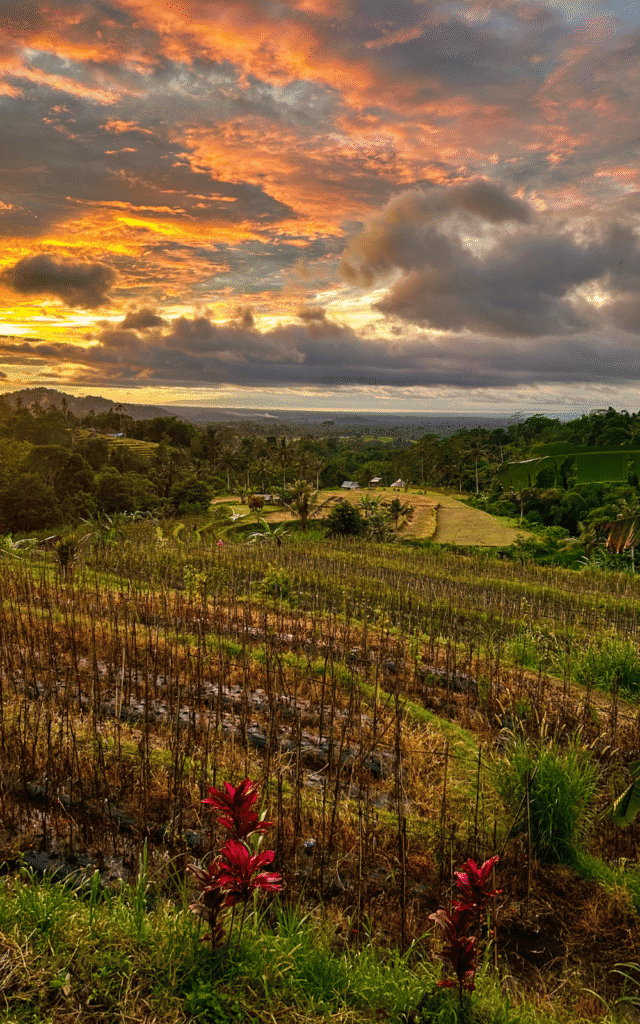
Second, the Jatiluwih Rice Terraces, a UNESCO-protected site that will make you completely forget about Tegallalang, and finally, Leke Leke Waterfall, one of my absolute favorites in Bali, hidden deep in a jungle valley at the end of a steep trail.
If this itinerary got you curious, I’ve shared all the details from my Central Bali trip here: what to expect, how to plan it, and of course, plenty of photos. (The post actually covers a two-day itinerary, but you can easily combine these three highlights into one full day.)
2. Kintamani Day Trip
Another absolutely exciting day trip from Ubud is Kintamani. It only takes about an hour to get there if you leave early in the morning, and in Kintamani there’s plenty to explore.
Kintamani is the region around Lake Batur, and from here you’ll get the most insane views of Mount Batur and Mount Agung you could possibly get.
A popular activity here is the Mount Batur sunrise hike, and you can plan it as a day trip, but don’t expect to do anything else afterwards, you’ll be so tired that all you’ll want is to go back to your hotel and sleep.
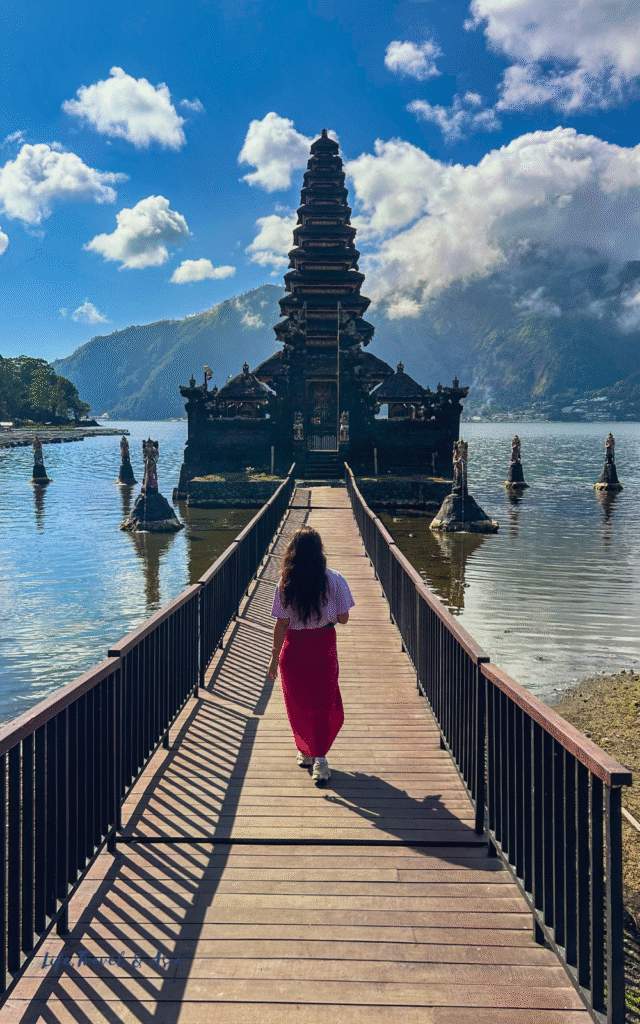
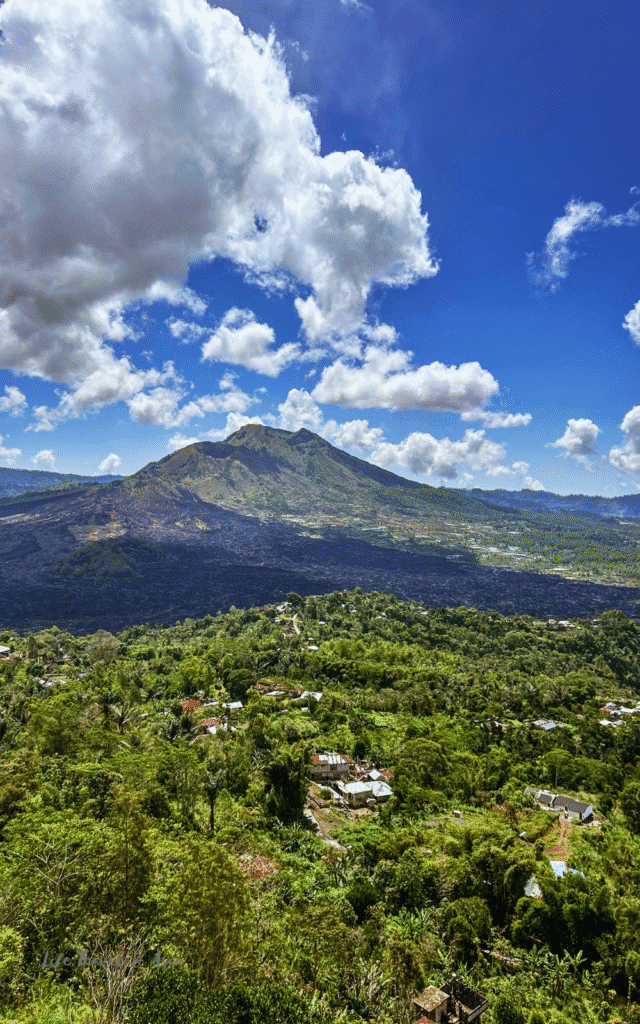
If that’s not for you, you can get to Kintamani, rent a scooter (the only way to get around here unless you book a driver), and explore the temples in the area (Pura Ulun Danu Batur and Pura Segara Ulun Danu—I know, the names are confusing).
You can also rent a bike and cycle around the lake or through small traditional villages. On your way back to Ubud, you can plan a stop at Pura Besakih, the most sacred temple in Bali (and much easier to reach from Kintamani than from Ubud).
If you’re interested and want to know more about this itinerary, check out my blog post about the Kintamani Day Trip I planned—you’ll find more about the sights to explore in the area and how to plan the trip from Ubud.
If you’re planning your Bali itinerary and thinking of using Ubud as your base, here are some other fun day trips around Bali worth adding to your list.
There you go! Here’s how I’d spend 3 days in Ubud (or more) if I were planning my trip for the first time. Now, Ubud is home for me, and I hope you get to see and experience the best of it—and love it like I did the first time.
If you ever find yourself with a free couple of hours, here’s a longer list of things you can do in Ubud. Besides the usual sights, you’ll discover hidden corners and more everyday activities like yoga or pottery.
And what about you? Have you already been to Ubud, or is this your first time? If you have any questions about visiting this whirlwind of a town, drop them in the comments—I’ll be happy to help!
Did you find it helpful? 📌 Save it on Pinterest!
